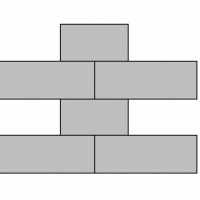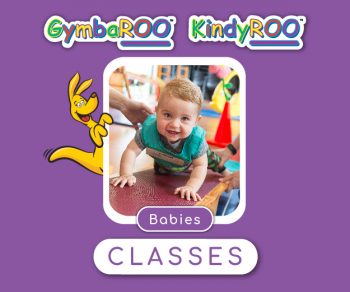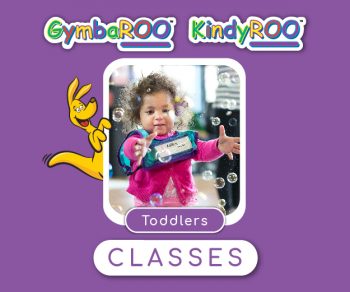Dr Jane Williams and Dr Tessa Grigg
In the past few years there have been lots of media articles warning us about the escalating numbers of children who are inactive, overweight and risk long-term health problems. Furthermore, children who are behind their peers in physical development when they start school are more likely to face social, emotional and academic challenges. Will regular physical activity in the first years of life make a difference? At GymbaROO we know children need to move so that they can learn. But there are some days when the weather makes a trip to the park problematic or you just run out of time. This article is here to explain why movement is helpful for the development of your preschooler and to provide ideas that may help busy parents with those ‘non-park’ days.
Unfortunately, the rising number of children who are overweight is more than just statistics on a page. Worldwide statistics reveal that there has been a dramatic rise in childhood obesity in the past 20 years. The latest research indicates that children who begin school with delayed physical development risk school failure (Pagani, Fitzpatrick, Archambault, & Janosz, 2010) and children who are obese risk chronic health problems in later life. The risk is compounded if a child’s stress levels are elevated – perhaps by years of unkind teasing at school by peers. As a result, experts agree that these issues have become a major health priority both nationally and internationally.
What can parents do?
It is evident that good health habits and regular physical activity established during the early years is likely to have long term benefits to both learning and health (Davis et al., 2011).
In order to combat the rising concerns over poor health in children most experts recommend that children eat a healthy diet and engage in 60 – 90 minutes of daily exercise. Yes, every day! A large proportion of children’s physical activity is incorporated in their daily life: in their playing, general activities, recreation, sport and family life. Exercise should include moderate intensity, continuous sustained bouts of physical activity and activity that reinforces a range of fundamental motor skills. Sedentary behaviours, such as watching television and playing computer games, should be reduced as much as possible, in fact children under 2 years of age should not watch screens at all!
Toddlers need to be involved in exercise that is sustained, prolonged, and where movement is not restricted, and children can practise their motor skills. The local park provides a great open space for running on the grass, exploring the gardens, swinging, spinning and tumbling over, jumping, hopping, skipping and riding scooters, trikes and bikes.
Two to five-year-olds should have the opportunity to participate in 30-45 minutes of structured physical activity daily as well as an hour of unstructured physical activity both indoors and outdoors.
Regular exercise ensures children stay fit, healthy and develop the fundamental motor skills essential for functional movement and learning in the classroom. It is a key ingredient to a happy, successful and healthy life.
Here are 10 tips for turning your house into a playground:
1: Set out a track for creeping/crawling games. Can the child creep/crawl on all fours with a pillow on their back?
2: Cover the white couch if you have one! Children will climb over, slide off, jump on, hang upside down off the couch when allowed. It is a very useful piece of play equipment.
3: Make a balance activity using a strip of something that will not slip, fabric, card, or rope. A balance ‘board’ does not need to be off the ground for preschoolers. In fact, they will be more adventurous if they know they will not fall.
4: Make a jumping course. Use flat cushions or similar so that children can jump from one to another. Make sure whatever you use will not slip on the flooring. And when that is easy for them: “Can you jump while holding something in one or both hands?”
5: Make tunnels. Tables with a sheet over them, or a sheet with a fold under the table legs so they have to push through.
6: Use chairs as a weaving activity. Place the chairs in a line and weave through them
7: Set up something low to jump over. Jumping provides many opportunities for skill development and children love to jump.
8: Make a simplified hop-scotch pattern using masking tape on the flooring. The number of squares will be determined by the age and skill of the child.

9: Sick a line of masking tape on the floor where there is some space. This can be used to roll like a pencil on the floor, so that the child has to roll in a straight line. It can be used as a balance beam and as something to jump over.
10: Use a hoop or masking tape on the floor to make a circle 40 cm diameter. Get the child to throw a bean bag into the hoop, increasing the distance as the skill increases. This circle can be used as part of the jumping track, or to do different types of jumping (backwards, sideways, jumping while counting etc.)
We hope you have fun creating movement opportunities at home. And when everyone is tired, they can build a hut and relax with a book!
Davis, C. L., Tomporowski, P. D., McDowell, J. E., Austin, B. P., Miller, P. H., Yanasak, N. E., & Naglieri, J. A. (2011). Exercise improves executive function and achievement and alters brain activation in overweight children: A randomized, controlled trial. Health Psychology, 30, 91–98. doi:https://doi-org.ezproxy.canterbury.ac.nz/10.1037/a0021766
Pagani, L. S., Fitzpatrick, C., Archambault, I., & Janosz, M. (2010). School readiness and later achievement: A French Canadian replication and extension. Developmental Psychology, 45, 984-994. doi:http://dx.doi.org/10.1037/a0018881
You may also like to read:
Outdoor physical play – why it’s important to your child’s development?









